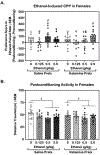Early-life ketamine exposure attenuates the preference for ethanol in adolescent Sprague-Dawley rats
- PMID: 32361040
- PMCID: PMC7521832
- DOI: 10.1016/j.bbr.2020.112626
Early-life ketamine exposure attenuates the preference for ethanol in adolescent Sprague-Dawley rats
Abstract
Ketamine, a noncompetitive N-methyl-d-aspartate (NMDA) receptor antagonist, produces quick and effective antidepressant results in depressed juvenile and adult individuals. The long-term consequences of using ketamine in juvenile populations are not well known, particularly as it affects vulnerability to drugs of abuse later in life, given that ketamine is also a drug of abuse. Thus, the current study examined whether early-life ketamine administration produces long-term changes in the sensitivity to the rewarding effects of ethanol, as measured using the conditioned place preference (CPP) paradigm. On postnatal day (PD) 21, juvenile male and female rats were pretreated with ketamine (0.0 or 20 mg/kg) for 10 consecutive days (i.e., PD 21-30) and then evaluated for ethanol-induced CPP (0.0, 0.125, 0.5, or 2.0 g/kg) from PD 32-39. Results revealed that early-life ketamine administration attenuated the rewarding properties of ethanol in male rats, as ketamine pretreated rats failed to exhibit ethanol-induced CPP at any dose compared to saline pretreated rats, which showed an increased preference towards the ethanol-paired compartment in a dose-dependent manner. In females, ethanol-induced CPP was generally less robust compared to males, but ketamine pretreatment resulted in a rightward shift in the dose-response curve, given that ketamine pretreated rats needed a higher dose of ethanol compared to saline pretreated rats to exhibit ethanol-induced CPP. When considered together, the findings suggest that early use of ketamine does not appear to enhance the vulnerability to ethanol later in life, but in contrast, it may attenuate the rewarding effects of ethanol.
Keywords: Addiction; Adolescence; Alcohol; Anhedonia; CPP; Reward.
Copyright © 2020 Elsevier B.V. All rights reserved.
Conflict of interest statement
Declaration of Competing Interest The authors declare no conflict of interest.
Figures




References
-
- Berman RM, Cappiello A, Anand A, Oren DA, Heninger GR, Charney DS, Krystal JH, Antidepressant effects of ketamine in depressed patients, Biol Psychiatry 47(4) (2000) 351–4. - PubMed
-
- Murrough JW, Iosifescu DV, Chang LC, Al Jurdi RK, Green CE, Perez AM, Iqbal S, Pillemer S, Foulkes A, Shah A, Charney DS, Mathew SJ, Antidepressant efficacy of ketamine in treatment-resistant major depression: a two-site randomized controlled trial, Am J Psychiatry 170(10) (2013)1134–42. - PMC - PubMed
-
- Zarate CA Jr., Singh JB, Carlson PJ, Brutsche NE, Ameli R, Luckenbaugh DA, Charney DS, Manji HK, A randomized trial of an N-methyl-D-aspartate antagonist in treatment-resistant major depression, Arch Gen Psychiatry 63(8) (2006) 856–64. - PubMed
Publication types
MeSH terms
Substances
Grants and funding
LinkOut - more resources
Full Text Sources

